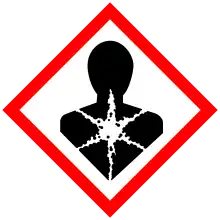Phenylmercury acetate
Phenylmercuric acetate is an organomercury compound used as a preservative, disinfectant, and antitranspirant.
 | |
-acetate-from-xtal-3D-balls.png.webp) | |
| Names | |
|---|---|
| Systematic IUPAC name
acetyloxy(phenyl)mercury | |
| Identifiers | |
3D model (JSmol) |
|
| 3662930 | |
| ChEBI | |
| ChEMBL | |
| ChemSpider | |
| ECHA InfoCard | 100.000.484 |
| EC Number |
|
| 83357 | |
| KEGG | |
| MeSH | Phenylmercuric+acetate |
PubChem CID |
|
| RTECS number |
|
| UNII | |
| UN number | 1674 |
CompTox Dashboard (EPA) |
|
| |
| |
| Properties | |
| C8H8HgO2 | |
| Molar mass | 336.742 g·mol−1 |
| Melting point | 148 to 151 °C (298 to 304 °F; 421 to 424 K) |
| Hazards | |
| GHS labelling: | |
    | |
| Danger | |
| H301, H314, H372, H410 | |
| P260, P264, P270, P273, P280, P301+P310, P301+P330+P331, P303+P361+P353, P304+P340, P305+P351+P338, P310, P314, P321, P330, P363, P391, P405, P501 | |
| Safety data sheet (SDS) | Oxford MSDS |
Except where otherwise noted, data are given for materials in their standard state (at 25 °C [77 °F], 100 kPa).
Infobox references | |
Properties
Phenylmercuric acetate forms colorless, lustrous crystals, and is soluble in ethanol, benzene, acetic acid, and sparingly in water.[1]
Applications
Phenylmercuric acetate has been used as a preservative in eyedrops and paint, disinfectant, former fungicide in agriculture, and a potential fungicide in leather processing.[1][2][3] It kills crabgrass, the seedlings of which are especially vulnerable, but leaves most lawn grasses intact.[4] It exhibits anti-fungal activity against a broad range of ocular pathogenic fungi, with the greatest activity against Fusarium spp, and has been investigated as a potential treatment for keratomycosis.[3]
Phenylmercuric acetate was used for disinfecting mucous membranes, but due to toxicological and ecotoxicological reasons, is no longer used.[5] Phenylmercuric acetate was once used commercially as a catalyst in 3M Tartan brand polyurethane flexible floors, a common flooring used in public buildings, especially in school gymnasiums, in the 1950's through 1970's.[6] In 2006, PMA was discovered to slowly leach from the 3M Tartan flooring in several Idaho public schools and was detectible using analytical methods of air monitoring via NIOSH 6009 Carulite Tubes and the Ohio-Lumex mercury vapor direct-reading analyzer.[6]
Hazards
Contact with phenylmercuric acetate can cause allergic reactions.[2], such as erythema and contact urticaria syndrome.[7][8] IgE plays a crucial role in contact urticaria syndrome pathogenesis.[8]
A rare side effect of phenylmercuric acetate in eye drops is mercurialentis, the buildup of pigment on the anterior capsule of the lens. This has been estimated to affect 18 of 500 patients who have used eye drops containing phenylmercuric acetate two to four times a day for more than six years. The pigmentation is not associated with visual impairment nor any ocular abnormalities.[3]
References
- Simon, Matthias; Jönk, Peter; Wühl-Couturier, Gabriele; Halbach, Stefan (2006). "Mercury, Mercury Alloys, and Mercury Compounds". Ullmann's Encyclopedia of Industrial Chemistry. doi:10.1002/14356007.a16_269.pub2. ISBN 978-3-527-30673-2.
- Geier, J.; Lessmann, H.; Uter, W.; Schnuch, A. (2005). "Patch testing with phenylmercuric acetate". Contact Dermatitis. 53 (2): 117–8. doi:10.1111/j.0105-1873.2005.0650d.x. PMID 16033409. S2CID 42906373.
- Xu, Y.; Zhao, D.; Gao, C.; Zhou, L.; Pang, G.; Sun, S. (2012). "In vitro activity of phenylmercuric acetate against ocular pathogenic fungi". Journal of Antimicrobial Chemotherapy. 67 (8): 1941–4. doi:10.1093/jac/dks133. PMID 22514262.
- Sunset Western Garden Book (1954), p.69
- Siebert, Jörg; Harke, Hans-Peter (2009). "Disinfectants". Ullmann's Encyclopedia of Industrial Chemistry. doi:10.1002/14356007.a08_551.pub2. ISBN 978-3-527-30673-2.
- Beaulieu, Harry J.; Beaulieu, Serrita; Brown, Chris (2008). "Phenyl Mercuric Acetate (PMA): Mercury-Bearing Flexible Gymnasium Floors in Schools — Evaluation of Hazards and Controlled Abatement". Journal of Occupational and Environmental Hygiene. 5 (6): 360–6. doi:10.1080/15459620802017425. PMID 18365889. S2CID 43701302.
- Maibach, H. I.; Johnson, H. L. (1975). "Contact Urticaria Syndrome: Contact Urticaria to Diethyltoluamide (Immediate-Type Hypersensitivity)". Archives of Dermatology. 111 (6): 726–30. doi:10.1001/archderm.1975.01630180054004. PMID 1137416.
- Torresani, Claudio; Caprari, Elisabetta; Manara, Gian Carlo (1993). "Contact urticaria syndrome due to phyenylmercuric acetate". Contact Dermatitis. 29 (5): 282–3. doi:10.1111/j.1600-0536.1993.tb03574.x. PMID 8112079. S2CID 46255307.